Central Asia's Tajikistan, Kyrgyzstan, Uzbekistan and Turkmenistan extends from modern India, Afghanistan, Iran to the Kaspian Sea above. This is the area from where the Aryans, destroying the Harappan civilization while driving away the Dravidians or Asuras, had entered India before 1500 AD, such a lie was spread by the imperialist and leftist historians. The reason was that here they had found abundant evidence of ancient Vedic culture and the most prominent evidence among them was that these people believed that the names of the gods and goddesses of the people of this region are exactly the same as that of the Aryans or that of the Indians. Therefore, there was Vedic Aryan civilization, culture, religion, tradition in ancient Central Asia and the people there were also the first eternally righteous Hindus, I do not need to prove this.
The second thing that the imperialist and leftist historians mention prominently is that in this Central Asia "Media" was located, from where the people were called Manda or Midi, some Aryans migrated to Iran and a large number of Aryans migrated to India. And ran. What was such a calamity, what was the reason that they had to leave their native place, some had to come to Iran and the rest to India, they have no answer to this question. Therefore, there is no need to waste time arguing on this point of these "retardants" because anyway the theory of Aryan invasion or the theory of Aryan migration etc. has been proved to be fake, fabricated and imperialist conspiracy in the seventies itself. .
Our research and evidence
We will tell you what is the reality of the migration of Aryans from Media to Iran and India and will prove that this region of Central Asia was not alien to India but has been a part of India since time immemorial. We will prove that the story of the fortunate sati, Savitri and Satyavan, which lives on the lips of every people in India, was the prince and princess of this region. Media was actually the state of Madra and Madri, the younger wife of Maharaj Pandu and mother of Nakula Sahadeva, was the princess of the state of Madra. His maternal uncle Shalya was the king of Salva, the country of Central Asia and will prove it. And then how and under whose rule the Hindu kings and subjects of Central Asia became Buddhists will also be discussed.
According to Grierson, the people of Media were Aryans and were here in 2500 BC. Aryans were dominant in the media. He defeated Subartu (?). Their gods were those whose names we find later in India and that they were Satem speakers, which is more closely related to ancient Sanskrit.
Commenting on the people of the Media, Will Durrau writes, "We do not know the origin of who the people of the Media were. We find the first mention of them on a plaque recorded in the campaign of Shalmanejar III in the hills of Kurdistan in a place called Parshua. This suggests that twenty-seven chieftains of the region, sparsely populated by people called Ahmadai, Madai or Meidi (meaning the people of Midiya), ruled. (Our Oriental Heritage, New York, Writer-Will Durant, Page-350)
According to Vayu Purana, the state of Madra was founded by Shibi, son of Ushinara, who was a descendant of Anu, son of Yayati. According to the Bhagavata Purana, the state of Madra was founded by Madra, who was the son of Shibi, a descendant of Anu, son of Yayati, in Tretayuga. That is, the state of Madra was established by Ushinara son Shibi and named after his son Madra or Shibi son Madra himself established the state of Madra.
According to Mahabharata, both Salva and Madra were twin kingdoms, their ancestors were also the same. These were the descendants of Vyushitasva, a descendant of Maharaj Puru. He performed the Ashwamedha Yagya and expanded his empire in the East, West, North, and South. He had seven sons, out of which three became the kings of Salva and four became the kings of Madra.
From both the above descriptions, it is concluded that the kingdom of Madra was established by the descendants of Anu, son of Yayati (since the mythological history is more ancient) but later the descendants of Yayati's son Puru took over it. He expanded the state of Madra in all four directions by conquering Digvijay and by dividing the state of Madra into North Madra, Dakshin Madra, West and East Madra, four Puruvanshi kings ruled. The discussion of Uttar Madra and Dakshin Madra is found in almost all historical texts. Paschim Madra has been discussed by Panini in his book. The Salva kingdom was probably located in the west adjacent to Madra, which was subjugated by Madra and therefore the border of Madra started touching Syria as shown in the description below.
The kingdom of Madra's boundaries are believed to have extended from Syria and portions of Mesopotamia to the present day (Madra). Some support for this belief lies within the ancient epic, the Mahabharata that describes the armies of the Madra Kingdom led by King Shalya, marching from ancient Syria to what would be known today as Haryana. (Menon, Ramesh (2006), The Mahabharata, A modern rendering. iUniverse. ISBN 9780595401888 . Ancient Peoples of the Punjab. University of Minnesota:K. L. Mukhopadhyaya. pp. vi, 7–8.)
Evidence from the story of Satyavan, Savitri and Madri
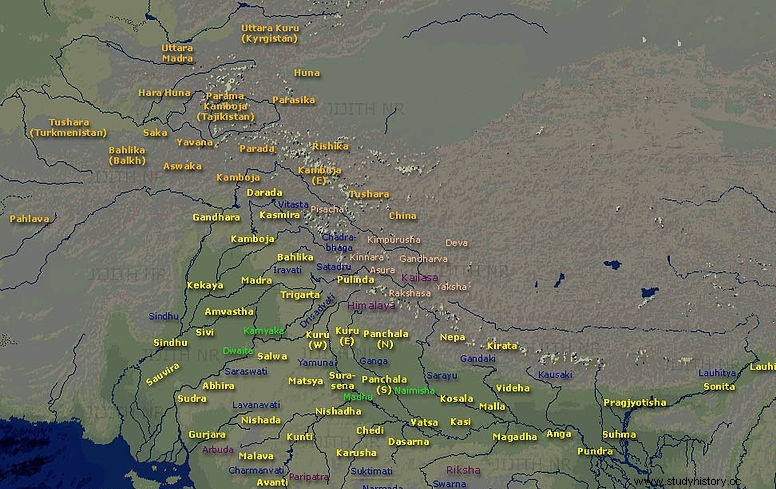
Ashwapati, a king of the Midiya ie Madra kingdom, was childless. He used to worship Savitra (Sun) along with his wife Malavika to get children, with whose blessings he had a daughter, whom he named Savitri. It is to be known that not only the story of Savitri but also the worship of Sun God for getting children is still sitting in the hearts and minds of Indians in the form of Chhath festival.
When Savitri grew up, Madra King Ashwapati gave her permission to find a groom for herself because in the Vedic period, there is a practice of choosing the bridesmaids themselves. While searching for her husband, she reached the neighboring country of Salva where she met Satyavan. Satyavan was the son and prince of Salva King Dyumtsena. The Salva king had become blind and was living with his wife in the forest where his son Satyavan used to serve him.
In the Mahabharata, Salva and Madra are sometimes called the states of western and sometimes northwestern India. It is clear from this that at least till the state of Madra and Salva in Central Asia, the land was called Bharatvarsha. Secondly, it has also been called the state of the west of India, which is today in the west of Afghanistan, which was also known as Aryan in ancient times, whose capital was probably Gandhara. Madri, the younger wife of Pandu and mother of Nakula Sahadeva, was the princess of Dakshin Madra while her maternal uncle Shalya was the king of the Salvas including North-West Madra.
Evidence from historical texts
Historian Bhagwan Singh writes that the north of the Manda or Midiya mythological period seems to be Madra and probably the region of north-west from Mandar came under its purview. For this the words manda, mandra etc. were prevalent. The use of the word honorary is found for them in the Rigveda.
The description of the location of Madra or Midiya and Mandarachal at one place in the Mahabharata has come in these forms:
Indra and Kubera protect Madra. In this area the aura of the Sun gets weakened. Its direction is northwest. This area is very wide. The existence of golden mountains and golden rivers exists here. From here the sun is visible very obliquely. In this region there are oceans made up of continuously flowing rivers. To reach this area, one has to cross the passes twice. There Kashyap and Maricha are the abode of the sages. (Harappan Civilization and Vedic Literature, author Bhagwan Singh)
It is clear from the above historical description that Central Asia was a part of ancient India and the state of Madra was established by the descendants of King Yayati in the Tretayuga era. Therefore, to say that there is a lot of evidence of ancient Vedic culture in Central Asia, therefore Indians, that is, Aryans must have come to India from Central Asia, is the ignorance of foreign historians and their slave leftist historians, and nothing else. Therefore there is no need for intelligent people to argue on them.
The truth of the departure of the Aryans from the Midiya or Madra country to Iran
Now let us tell what is the reality of some Aryans going towards Iran. In fact, Giridhar Sharma Chaturvedi presents this story about the religious differences between the Indian and Iranian branches, which have been said to be the cause of migration till date,
“Starting from the 86th hymn of the tenth mandala of the Rigveda, a verse is indicated in the subsequent hymns. There was a person named Zarathustra, the brother-in-law of Rijrasva Rishi, his heart naturally had hatred towards the brahmins of that period. Zarathustra, going by tradition, rejected Indra's preference and established Varuna in his place. Its indication is found in the Nedra Devammansat Mantra of the Rikasamhita. Among the sages present, Nirimedha, Vamadeva, Gargya etc. took the side of Indra and Suparna, Kanva, Bharadwaj etc. took the side of Varuna and Vashishtha etc. respected both of them in their respective places. Therefore, the supporters of Varuna left for "India to Iran" under the leadership of Zarathustra. (Girdhar Sharma Chaturvedi, Vedic Science and Indian Culture, Patna and Indian Civilization in the Rigvedas, Yeotmal by P R Deshmukh)
Note that both the above historians have considered the extensive media in Central Asia i.e. Madra as a part of India, so they have written like "they left from India to Iran". If we talk about the time-determination of this event, then this incident seems to be of Tretayuga by the name of the sages. Bhriguvanshi Zarathrusha came to Iran and spread his faith. Some sources reveal that Bhrigu Rishi himself was also born in present-day Iran and settled in Bhrigukachha (Bharuch) only after coming from Iran.
The Parthians/Pahlava Kshatriyas ruled Iran. He is mentioned in Mahabharata only as Kshatriya. The Sassanids and Samanid Kshatriyas may be originally from Iran who later settled in Central Asia and Khorasan. The Samanid Kshatriyas used the word "Nuh", a shortened form of the word "Manu" at the end of their name as a title or surname. From this historian PN Oak speculates that these people may have been Kshatriyas, the maintainers and guardians of Manusmriti.
Historian PN Oak writes, "Before the establishment of the Praja State in Iran, the last princely state was the Pahlavi Gharana. Pahlavi were Kshatriya people who followed Vedic religion. He is mentioned in Mahabharata and Puranas. When Vishwamitra snatched Vashishtha's Kamdhenu and took it away, the Kshatriya clan who came running to protect Kamdhenu was the Pahlava"
Parashurama had repressed the wicked Kshatriyas by communicating in the world twenty one times. Once out of them, he climbed that part of India which is today called Iran. Edward Pokok has written on page 45 of his book India in Greece that after Parashudhar Parashurama conquered Iran, that country got the name Parsik alias Persiya from Parashu.
He has also written in his book that, "The ancient maps of Iran, Colchis and Armenia give clear and surprising evidence of the Indians settled in those regions. And there is evidence of many facts of Ramayana and Mahabharata. In all those maps, a large amount of details of the settlement of Indians in those regions are found. (Page 47, India in Greece by Edward Pococke)
Were there only Indian business establishments in Central Asia?
Historians who believe in the Out of India theory, the reason for getting abundant evidence of Vedic civilization, culture, religion and tradition found in Central Asia, the reason for the people who went to trade from India, there were abundant trading establishments and many settlements of Indians settled there. admit. As historian Bhagwan Singh puts it, "There is every possibility that the Aryan speakers of the Media may have migrated to the region from India or were at least in close contact with Indian merchants."
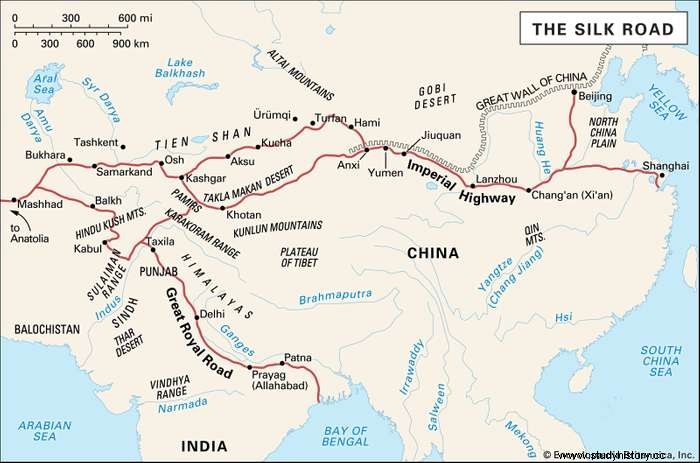
Bhagwan Singh believes that the trade of Vedic Aryans was very developed and foreign trade was done on a large scale. Central Asia was the busiest trade route since the pre-Vedic period, located on the Silk Road, where trade from Tamralipti (Bang) to the Silk Road (GT Road) carried extensive trade to Central Asia and then from Central Asia to Europe. The Indian Vedic traders traded at the highest level even before the mature Harappan period. Therefore, there were permanent trading establishments of Indian merchants in Central Asia and settlements of Indians were also settled. Therefore, the abundant evidence of Vedic civilization, culture, religion, tradition which is found in Central Asia is actually due to these Indians.
Sites like Namazga, Hisar, Altin Depe, Tejen delta, Kyijil Kum, Shortugai etc. have a visible connection with the Harappan civilization, which in some cases started even before the mature Harappan period. The word Midiya has been used for the western part of this region. Soviet scholars have also considered India as their center of spread. (Harappan Civilization and Vedic Literature, author Bhagwan Singh)
Will Durant, the author of Our Oriental Heritage, has written in his book that from the beginning of AD to 1500 AD, India's share in the total trade of the world was two-third.
I have a slight difference of opinion with the historian Bhagwan Singh. Central Asia was a great trading area. पर सिल्क मार्ग से चीन का व्यापार भी बृहत् स्तर पर होता था. चीन के व्यापारी भी मध्य एशिया में रुकते थे क्योंकि यूरोप की ओर व्यापार केलिए मध्य एशिया एक व्यापारिक चौराहे का काम करता था. अतः उनके भी व्यापारिक प्रतिष्ठान वहां रहे होंगे. तो फिर वहां से प्राचीन चीनियों के सभ्यता, संस्कृति और धर्म के अवशेष भी वैसे ही मिलने चाहिए थे जैसे भारतियों के मिलते हैं?
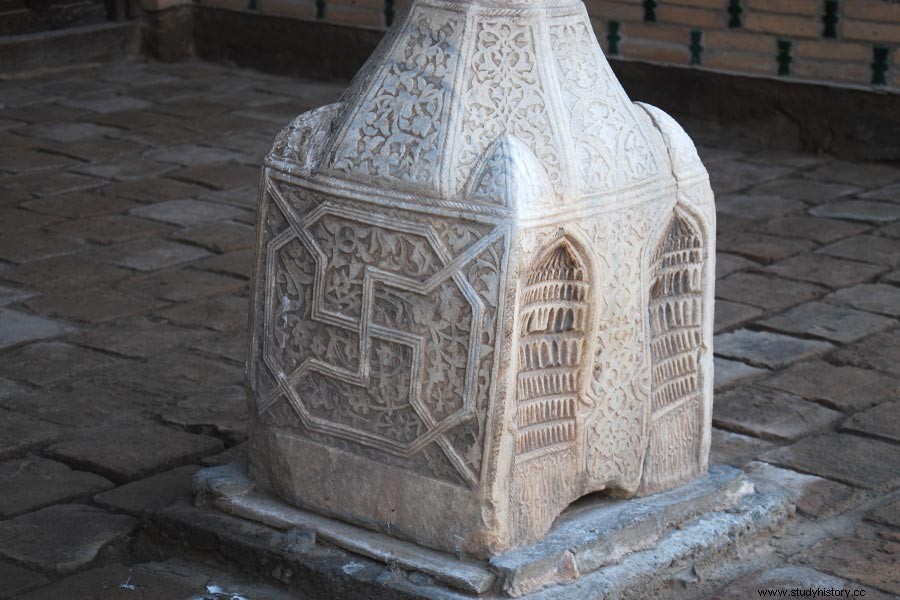
पर ऐसा नहीं है. अतः यह कहना कि मध्य एशिया में वैदिक सभ्यता संस्कृति धर्म परम्परा के चिन्ह विपुल मात्रा मिलने का कारण केवल व्यापार, व्यापार केलिए बने प्रतिष्ठान और व्यापार केलिए गये भारतियों के कारण है तो यह अधूरी बात होगी. वास्तविकता वह है जो इतिहास मैंने उपर लिखा है कि वहां भारतीय त्रेतायुग या उससे पहले ही बस गये थे और यह कि मध्य एशिया भी प्राचीन भारतवर्ष का हिस्सा था. इतना ही नहीं ग्रीकों और बौद्धों से पूर्व मध्य एशिया के लोग आर्य संस्कृति को मानने वाले लोग ही थे और जो लोग बाद में बौद्ध बने वे हिन्दू ही थे. इस बात का विस्तृत प्रमाण आगे लेख में दिया जायेगा.
गोडफ्रे हिगिंस के ग्रन्थ The Celtic Druids के पृष्ठ ४३ से ५९ पर उल्लेख है कि “भारत के नगरकोट, कश्मीर और वाराणसी नगरों में, रशिया के समरकंद नगर में बड़े विद्याकेंद्र थे जहाँ विपुल संस्कृत साहित्य था.” समरकन्द मध्य एशिया का देश उज्बेकिस्तान का एक शहर है. इन्होने “विद्याकेंद्र” लिखा है व्यापार केंद्र नहीं.
लेखक Marie Grahams लिखते हैं, “प्राचीनकाल से भारत और समरकंद में लोगों का आना-जाना बड़े प्रमाण में बराबर होता रहा है. बाह्लीक प्रदेश (बल्ख) और अन्य उत्तरी नगरों में अनादिकाल से हिन्दुओं की बस्तियां हैं. हिन्दुओं का यहाँ एक प्राचीन तीर्थस्थल भी है जिसका नाम ज्वालामुखी है. वह काश्यपीय (Caspian) सागर तट पर स्थित है.” (letters on India, Writer-Marie Grahams)
भारत के १६ महाजनपदों में एक कम्बोज मध्य एशिया में था

कंबोज प्राचीन भारत के १६ महाजनपदों में से एक था. इसका उल्लेख पाणिनी के अष्टाध्यायी और बौद्ध ग्रन्थ अंगुत्तर निकाय और महावस्तु मे कई बार हुआ है. राजपुर, द्वारका तथा कपिशा इनके प्रमुख नगर थे. इसका उल्लेख इरानी प्राचीन लेखों में भी मिलता है जिसमें इसे राजा कम्बीजेस के प्रदेश से जोड़ा जाता है. (डॉ रतिभानु सिंह (१९७४). प्राचीन भारत का राजनैतिक एवं सांस्कृतिक इतिहास. इलाहाबाद, पृ॰ ११२.)
वाल्मीकि-रामायण में कंबोज, बाह्लीक और वनायु देशों को श्रेष्ठ घोड़ों के लिये उत्तम देश बताया है. महाभारत में अर्जुन की दिग्विजय के प्रसंग में कम्बोज का लोह और ऋषिक जनपदों के साथ उल्लेख है (सभा. २७, २५)
ऋषिक यूची का रूपांतरण जान पड़ता है. यूची जाति का निवास स्थान शिनजियांग प्रान्त के घास स्थल में माना जाता है. प्रसिद्ध बौद्ध सम्राट् कनिष्क का रक्तसंबंध इसी जाति के कुशान नामक कबीले से था. (विकिपीडिया)
इतिहासकार पी एन ओक रशिया का प्राचीन नाम ऋषिय प्रदेश बताते हैं क्योंकि उनके अनुसार यह प्रदेश ऋषियों, मुनियों का तपस्या स्थल हुआ करता था. अतः मेरा मत है कि ऋषिक जनपद का मतलब ऋषिय प्रदेश (रशिया) के जनपद से भी हो सकता है. कम्बोज का ताजीकिस्तान वाला हिस्सा कुछ दशक पूर्व तक सोवियत रूस का ही हिस्सा था.
महाभारत के वर्णन में कंबोज देश के अनार्य रीति रिवाजों का आभास मिलता है. भीष्म. ९,६५ में कांबोजों को म्लेच्छजातीय बताया गया है. मनु ने भी कांबोजों को दस्यु नाम से अभिहित किया है तथा उन्हें म्लेच्छ भाषा बोलनेवाला बताया है (मनुस्मृति १०, ४४-४५). मनु की ही भाँति निरुक्तकार यास्क ने भी कांबोजों की बोली को आर्य भाषा से भिन्न कहा है.
ऋग्वेद में वैदिक व्यापारियों के मार्गों में खलल डालने वाले, उन्हें लूट लेनेवाले जिन दस्युओं का उल्लेख बार बार आया है वे कम्बोज हो सकते हैं क्योंकि ये वैदिक व्यापार मार्ग सिल्क मार्ग पर स्थित थे. कम्बोज आर्य भाषा नहीं बोलते थे मतलब सतेम या संस्कृत भाषी नहीं थे अर्थात यही ऋग वैदिक मृधवाची भी हो सकते हैं.
उपर्युक्त तथ्यों से भी कम्बोज कि अवस्थिति मध्य एशिया ही प्रतीत होती है जो आधुनिक ताजीकिस्तान और शिनजियांग प्रान्त में विस्तृत था क्योंकि अफगानिस्तान, कश्मीर से गोदावरी तक भारत तो सतेम, संस्कृत या इसके तद्भव भाषा का ही प्रयोग करते थे. इतिहासकारों का मानना है कि कम्बोज उत्तरापथ पर स्थित था जो बंग से कश्मीर, काबुल होते हुए मध्य एशिया जाता था. पर हमें ध्यान रखना होगा कि यही मार्ग कश्मीर में चीनी सिल्क मार्ग से भी जुड़ जाता था और चीनी तुर्किस्तान होते हुए मध्य एशिया पहुंचता था. यह भी सम्भव है प्राचीन काल में पूरा सिल्क मार्ग उत्तरापथ कहलाता हो जैसे आज ब्रिटेनिका के अनुसार पूरा मार्ग सिल्क रूट कहलाता है. कम्बोज एक शक्तिशाली राज्य था और जहाँ वह स्थित था उसका विस्तार भारतीय उतरापथ और चीनी सिल्क मार्ग के बीच सम्भव है और ऐसा प्रमाण भी मिलता है कि कम्बोजों ने उत्तरी अफगानिस्तान और उत्तर-पश्चिम कश्मीर पर भी अधिकार कर लिया था.
बहुत से पुराणों में कैकेय, गंधर्व, शक, परद, बाह्लीक, कंबोज, दरदास, चीनी, तुषार, पहलव आदि के लोगों को उदीच्य यानि उत्तरापथ की उत्तरी मंडल का निवासी बताया है. पुरातत्वेताओ ने घोरबंद और पंजशीर नदी के मिलन स्थल पर स्थित ‘बेग्राम’ नामक स्थान पर प्राचीन कपिशा, जो कम्बोज का एक नगर था, के अवशेषों को खोज निकाला हैं. यह आधुनिक काबुल और बामियान के बीच रेशम मार्ग पर काबुल से ५० मील उत्तर में स्थित था. (विकिपीडिया)
परन्तु अर्जुन के कम्बोज के विजय के बाद कम्बोज आर्य संस्कृति के प्रभाव में आ गया और भारतवर्ष का एक शक्तिशाली जनपद बन गया. हालाँकि पांडवों से वैर के कारण कम्बोजों, शकों आदि ने महाभारत में कौरवों के पक्ष में युद्ध किया था पर महाभारत में पांडवों के विजय के बाद वह युद्धिष्ठिर के साम्राज्य का हिस्सा बन गया होगा. इसीलिए उसकी गणना परवर्ती काल में भारतवर्ष के महाजनपद के रूप में होने लगी थी.
कंबोज में बहुत प्राचीन काल से ही आर्यों की बस्तियाँ बिद्यमान थीं. इसका स्पष्ट निर्देश वंशब्राह्मण के उस उल्लेख से होता है जिसमें कांबोज औपमन्यव नामक आचार्य का प्रसंग है. यह आचार्य उपमन्यु गोत्र में उत्पन्न, मद्रगार के शिष्य और कंबोज देश के निवासी थे. इतिहासकार कीथ का अनुमान है कि इस प्रसंग में वर्णित औपमन्यव कांबोज और उनके गुरु मद्रगार के नामों से उत्तरमद्र और कंबोज देशों के सन्निकट संबंध का आभास मिलता है. बौद्ध ग्रंथ मज्झिमनिकाय से भी कंबोज में आर्य संस्कृति की विद्यमानता के बारे में सूचना मिलती है.
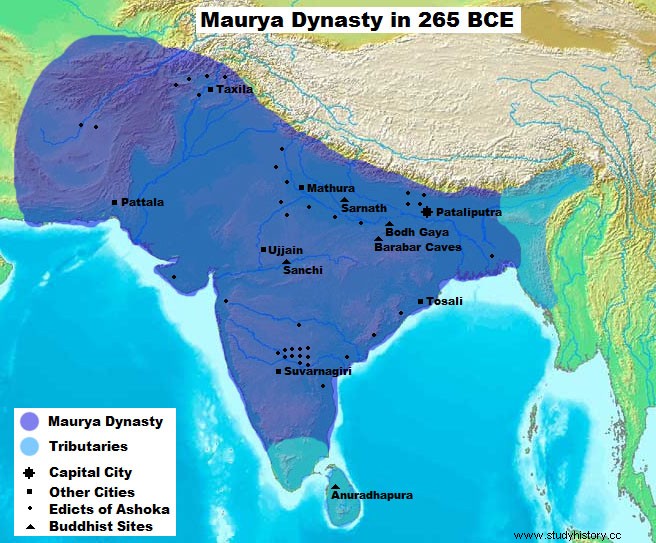
कौटिल्य के अर्थशास्त्र में कंबोज के ‘वार्ताशस्त्रोपजीवी’ संघ का उल्लेख है जिससे ज्ञात होता है कि मौर्यकाल से पूर्व यहां गणराज्य स्थापित था. अशोक के अभिलेखों में कांबोजों का उल्लेख नाभकों, नाभपंक्तियों, भोजपितिनकों और गंधारों आदि के साथ किया गया है (शिलालेख १३). इस धर्मलिपि से ज्ञात होता है कि यद्यपि कंबोज जनपद अशोक का सीमावर्ती प्रान्त था तथापि वहाँ भी उसके शासन का पूर्ण रूप से प्रचलन था. इससे भी कम्बोज मध्य एशिया के उत्तर-पूर्व अफगानिस्तान और ताजीकिस्तान का भाग प्रतीत होता है (मानचित्र देखें).
मुम्बई से प्रकाशित टाईम्स ऑफ़ इंडिया के ३० अगस्त १९८२ के सांध्य दैनिक में एक न्यूज प्रकाशित हुआ था कि ताजीकिस्तान (कम्बोज) में एक स्थान पर एक प्राचीन भवन कि दीवार पर वैदिक रथ का चित्र रेखांकित पाया गया.
मध्य एशिया में बौद्ध राज्यों का उदय और प्रसार
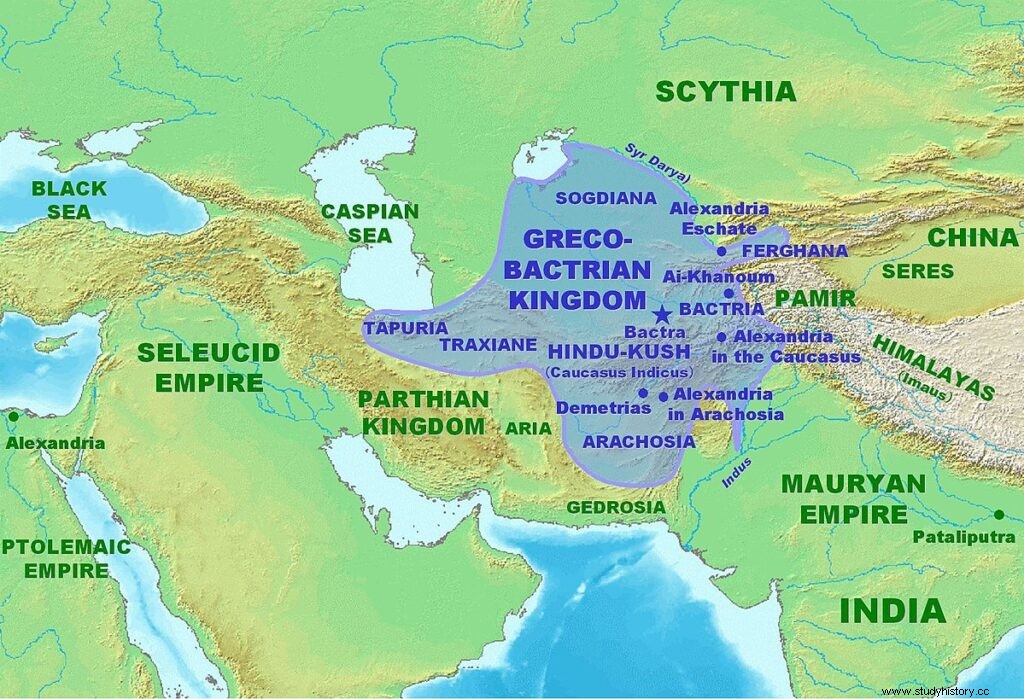
मध्य एशिया में प्रथम बौद्ध राज्य बैक्ट्रिया था. बैक्ट्रिया का शासक मिनांडर भारतीय बौद्धों के सहयोग से भारत पर विजय पाना चाहता था इसलिए वह बौद्ध बन गया था. बौद्धों के सहयोग से वह भारत में अंदर तक घुसने में सफल भी हुआ था पर पुष्यमित्र शुंग ने उसे वापस बैक्ट्रिया तक ढकेल दिया. इतिहास में इन्हें ग्रीको-बैक्ट्रियन बौद्ध कहा जाता है. इन्ही के द्वारा ग्रीस में बौद्ध धर्म फैला था. इसके बाद कुषाणों ने ग्रीको-बैक्ट्रियन राज्य को खत्म कर मध्य एशिया से मध्य-पूर्व एशिया में बौद्ध धर्म और बौद्ध राज्य का प्रसार किया.
लेख बहुत बड़ा होने के कारण मध्य एशिया में बौद्ध राज्यों के उदय का इतिहास, उज्बेकिस्तान के बौद्ध तीर्थस्थलों के सचित्र विवरण और मुस्लिम आक्रमणकारियों द्वारा बौद्ध राज्यों, बौद्धों और बौद्ध धर्म के सम्पूर्ण विनाश का इतिहास निचे के लेख में अलग से प्रस्तुत किया गया है:
